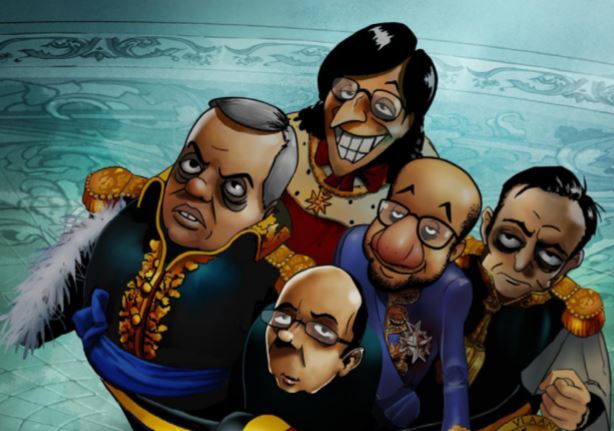- Daily & Weekly newsletters
- Buy & download The Bulletin
- Comment on our articles
Animated film spanning 35 years of Belgian history is a surprising hit
One of the surprise crowd-pleasers at last year’s International Francophone Film Festival (Fiff) was the animation Leopold, King of the Belgians. As a prime promoter of French-language cinema, the Namur festival was a fitting launch-pad for the quirky comedy that’s entirely made in Wallonia. Combining history and humour, the jewel of a film succeeds in seducing audiences young and old.
It’s the first major project for Mad Cat Studio, an artistic collective that operates from Namur and Liège. For co-director Matthieu Collard, the feature reflects the creative freedom of the studio’s independent structure. “There’s much more artistic liberty when money is not involved. The film is extraordinary because we had the freedom to make the film we wanted,” he says, in reference to the complex structure and conditions surrounding the financing of the majority of films.
Based in Namur, the former historian juggles theatrical roles with his work for Mad Cat. Both the studio and film arose from a collaboration with Liège film illustrator Cédric Vandresse, who approached Collard in 2013 with an idea for a little film lasting about five minutes on Belgium’s first monarch. They set up a non-profit with other animators to offset the precarity of their profession and the traditional producer/artist division in the film industry, which subsequently became a production studio cooperative.

The political rise of the N-VA party in Flanders also spurred them into action. Collard: “There were a lot of negative things being said about Belgium and we didn’t agree. In the shared conviction to do something on Belgium, it was the story of Leopold that arose. We are proud of our history.” An additional appeal was the setting. “Cédric likes the gothic world and Leopold I was known as the vampire king, as well as having this obscure side to him,” he says. Interest in the project also included the fact that Belgium has played a significant role in European history.
The film starts dramatically, with caricaturised monarchs astride seats of power as they carve up the continent in an intriguing board game. The unenviable task of constructing a new nation and maintaining peace in Europe falls on the shoulders of young German prince Leopold. While the story traces Leopold over a period of 35 years, neglecting other figures, the team aimed for historical accuracy. “We tried to recount the story of someone who gave his life to a country perhaps to the detriment of his family,” says Collard. Based on documents and letters, they saw that Leopold expressed concern about his son, the controversial Leopold II.
In a comic tour de force, Leopold is surrounded by the familiar faces of currentday politicians, from prime minister Charles Michel and French president Emmanuel Macron to Bart De Wever and Didier Reynders. “It’s funny and it enables the audience to understand who and what these characters are. People like the surprise,” says Collard. Belgium’s unmistakable sense of humour is a unifying thread. “In one scene with the generals and Belgian army, when soldiers reply that they don’t have any rifles and anyway they couldn’t care less because they don’t have any bullets, the audience appreciates the self-deprecation,” he says.
The enchantment of the film also lies in its sumptuous visuals: resonant and droll images of the royal palace in splendid dilapidation. “Cédric’s great force is that his drawings are at such a high level. Using the colours and light, the desire was to recreate oil paintings of the 19th century,” says Collard.

While the Mad Cat team are proud of their first major oeuvre, they recognise the need to learn lessons. “We have to improve our production methods and timings. This project took us further than we had ever imagined and we made errors, but we also discovered a new profession,” Collard says. They are now focusing on the film’s distribution and screening at key festivals such as Anima in Brussels in February and Annecy in France in June. There is already a VO version of the film with English subtitles, as well as another dubbed in German, thanks to the film having been bought by Franco-German cultural TV channel Arte.
Its medium-length format of 47 minutes is proving something of a challenge, however, as it is too short for conventional cinemas and the current mode is for series of 50-minute episodes, explains Collard. But with its educational credentials, viewings for schools in cultural centres are already under way, and they also have their sights set on art-house cinemas amid other opportunities.
The team is equally busy with future projects: short films and a full-length feature exploring the world of witches in a medieval setting. “It’ll have pine trees like the Ardennes, but the interior will be a mixture of Venice for its water setting and Prague’s darkness, witches, cats and vampires,” says Collard. The aim is to reverse stereotypes and present witches as a ray of sunshine within an otherwise bleak landscape. “The reality is that in the Middle Ages, witches organised parties among tightknit villages to encourage a genetic mix and they also passed on medical know-how,” he adds. While technical and financial hurdles remain, there’s no doubting Mad Cat Studio’s creative self-belief and ambition.
This article first appeared in Wab (Wallonia and Brussels) magazine

















